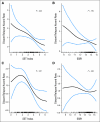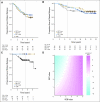Genomic index of sensitivity to endocrine therapy for breast cancer
- PMID: 20697068
- PMCID: PMC2953969
- DOI: 10.1200/JCO.2010.28.4273
Genomic index of sensitivity to endocrine therapy for breast cancer
Abstract
Purpose: We hypothesize that measurement of gene expression related to estrogen receptor α (ER; gene name ESR1) within a breast cancer sample represents intrinsic tumoral sensitivity to adjuvant endocrine therapy.
Methods: A genomic index for sensitivity to endocrine therapy (SET) index was defined from genes coexpressed with ESR1 in 437 microarray profiles from newly diagnosed breast cancer, unrelated to treatment or outcome. The association of SET index and ESR1 levels with distant relapse risk was evaluated from microarrays of ER-positive breast cancer in two cohorts who received 5 years of tamoxifen alone as adjuvant endocrine therapy (n = 225 and 298, respectively), a cohort who received neoadjuvant chemotherapy followed by tamoxifen and/or aromatase inhibition (n = 122), and two cohorts who received no adjuvant systemic therapy (n = 208 and 133, respectively).
Results: The SET index (165 genes) was significantly associated with distant relapse or death risk in both tamoxifen-treated cohorts (hazard ratio [HR] = 0.70, 95% CI, 0.56 to 0.88, P = .002; and HR = 0.76, 95% CI, 0.63 to 0.93, P = .007) and in the chemo-endocrine-treated cohort (HR = 0.19; 95% CI, 0.05 to 0.69, P = .011) independently from pathologic response to chemotherapy, but was not prognostic in two untreated cohorts. No distant relapse or death was observed after tamoxifen alone if node-negative and high SET or after chemo-endocrine therapy if intermediate or high SET.
Conclusion: The SET index of ER-related transcription predicted survival benefit from adjuvant endocrine therapy, not inherent prognosis. Prior chemotherapy seemed to enhance the efficacy of adjuvant endocrine therapy related to SET index.
Conflict of interest statement
Authors' disclosures of potential conflicts of interest and author contributions are found at the end of this article.
Figures



Comment in
-
Is it time to ReSET the standard for estrogen receptor testing in breast cancer?J Clin Oncol. 2010 Sep 20;28(27):4101-3. doi: 10.1200/JCO.2010.30.9864. Epub 2010 Aug 9. J Clin Oncol. 2010. PMID: 20697070 No abstract available.
References
-
- Winer EP, Hudis C, Burstein HJ, et al. American Society of Clinical Oncology technology assessment on the use of aromatase inhibitors as adjuvant therapy for postmenopausal women with hormone receptor-positive breast cancer: Status report 2004. J Clin Oncol. 2005;23:619–629. - PubMed
-
- Winer EP. Optimizing endocrine therapy for breast cancer. J Clin Oncol. 2005;23:1609–1610. - PubMed
-
- Swain SM. A step in the right direction. J Clin Oncol. 2006;24:3717–3718. - PubMed
-
- Perou CM, Sorlie T, Eisen MB, et al. Molecular portraits of human breast tumours. Nature. 2000;406:747–752. - PubMed
Publication types
MeSH terms
Substances
Associated data
- Actions
- Actions
Grants and funding
LinkOut - more resources
Full Text Sources
Other Literature Sources
Medical
Molecular Biology Databases
Miscellaneous

